
Niobium-tungsten alloys have good room temperature plasticity and can be processed into plates, rods and various complex profiles; high high-temperature strength and low density compared with other tungsten, molybdenum and tantalum alloys, which makes them refractory metal high-temperature structural materials favored by the aerospace and nuclear industries. Niobium alloys are very sensitive to the O element in gases. Although the solubility of the O element in niobium alloys is low, niobium alloys are very susceptible to oxidation and can only be used under the protection of antioxidant coatings or in vacuum environments. Oxidation tests were carried out on Nb521 niobium-tungsten alloy at different temperatures in a low oxygen environment (20 ppm) to investigate the effect of the diffusion of O elements from gases in the working environment on the mechanical properties of the alloy.
1 Test materials and methods
Oxidation of tensile specimens for 54mm × 10mm × 2mm sheet sample, working section size of 20m long, 4mm wide, Nb521 alloy specific composition is shown in Table 1. Specimen surface for the recrystallization of the annealed rolled surface, the specimen end of the face by the cutting of the surface of the 2000# sandpaper polished, and then ultrasonically cleaned with water and alcohol and then dried in turn. Oxidation tests were carried out in a quartz tube multi-atmosphere reaction tube furnace at temperatures of 500, 600, 700 and 800°C, oxidation time of 4 h, and oxidizing atmosphere of helium-oxygen (20 ppm) with a gas flow rate of 40 mL/min. The specimens were oxidized at different temperatures and then tensile stretched at room temperature with a tensile rate of 1 mm/min. The specimens were torn at room temperature with a tensile rate of 1 mm/min. The specimens were oxidized using a JSM6460, The oxidized film and tensile fracture of the specimens were analyzed by JSM6460, EVO10 scanning electron microscope and D8ADVANCE X-ray diffractometer.

2 Results and Analysis
2.1 Effect of oxidation on mechanical properties of alloys
Table 2 shows the mechanical properties of the oxidized alloys at different temperatures.

Can be seen, the sample in 500 ℃ after oxidation of the tensile strength, yield strength oxidation temperature on the mechanical properties of Nb521 alloy and elongation of the degree of oxidation and no oxidation (25 ℃) compared to the performance of the specimen is basically the same, 600 ℃ oxidation of the tensile strength and yield strength did not change much, but the elongation of the change is large, falling quickly, from 500 ℃ when 24% to 15%, down about 37.5%; when the oxidation temperature reaches 700 ℃, the mechanical properties of the alloy after oxidation of the oxidation temperature of the oxidized alloy. When the oxidation temperature reaches 700 ℃, the yield strength and elongation is 0, brittle fracture, and 800 ℃ oxidation, and there is a certain yield strength and elongation. On the other hand, when the oxidation temperature from 500 ℃ to 700 ℃, the sample surface hardness with the oxidation temperature increases, 700 ℃ when the hardness value than 600 ℃ when the hardness increased by a factor of 1. When the oxidation temperature reaches 800 ℃, the hardness value decreases again, indicating that the diffusion of oxygen elements in the alloy surface is intensified at 700 ℃ and slowed down at 800 ℃.
Figure 1 shows the surface morphology of the specimen after oxidation at different temperatures. It can be seen that the surface morphology changes greatly after oxidation at different temperatures. At 500 ℃ oxide film uneven, ridge growth, the surface of a large number of white particles generated; 600 ℃ oxide film surface white particles in the reduction; 700 ℃ oxide film surface white particles have been very few; 800 ℃ oxidation of the surface of the oxide film tends to be flat, dense.

Figure 2 XRD analysis of the oxide film at different temperatures. It can be seen that at 500 ℃, the surface oxide is mainly NbO2 and Nb4O5 and accompanied by part of the ZrO2 generation; 600 ℃ is mainly NbO2 and Nb4O5; 700 ℃ NbO2 in the increase; 800 ℃ is mainly NbO2. The above test results show that, at different temperatures, the change of the oxide in the surface oxide film affects the mechanical properties of the alloy, in 500 ℃ oxidation, the O element in the atmosphere environment is very small, the surface oxide film tends to be flat and dense after oxidation. When oxidized at 500℃, the O element in the atmosphere environment reacts with the Nb and Zr elements in the alloy through diffusion and starts to generate the oxides of Nb and Zr; with the rise of oxidizing temperature, the number of ZrO2 oxides decreases and the number of NbO2 oxides increases. This is because the Zr element is a reactive element, O element is easy to combine with the Zr element to generate ZrO2 oxide. With the depletion of Zr element on the surface of the alloy, O element reacts with Nb element to form Nb oxide. After oxidation at 500-700℃, the oxide film on the surface of the alloy is not dense, indicating that the generated Nb4O5 oxide is a nonprotective oxide film, which cannot hinder the diffusion of O elements into the metal. With the increase in temperature, oxygen diffusion intensified, greatly impairing the mechanical properties of the alloy, resulting in brittle fracture of the alloy at 700 ℃. When the oxidation temperature rises to 800 ℃, the surface oxide film of the alloy is denser, and the surface oxide is mainly NbO2. This indicates that NbO2 has protective properties, which can impede the further deep diffusion of O element and reduce O element diffusion.
This indicates that NbO2 has protective properties, which can hinder the further deep diffusion of O element, reduce the damage of O element to the mechanical properties of the alloy, and repair the properties of the alloy.
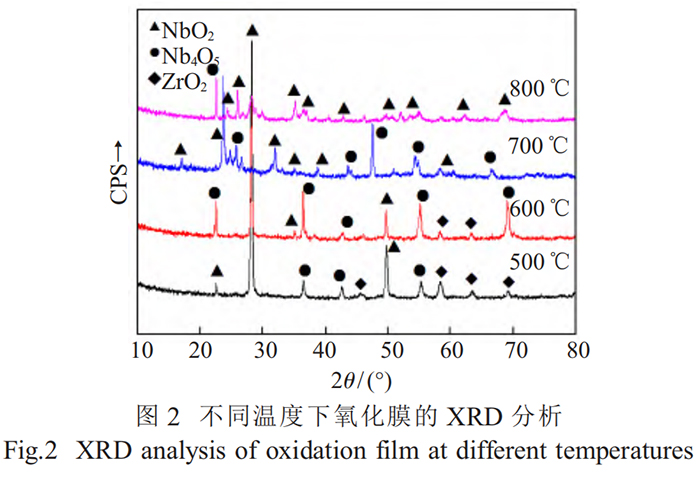
2.2 Changes of tensile fracture morphology
Figure 3 shows the tensile fracture morphology of the oxidized samples at different temperatures. It can be seen, in 500 ℃, the fracture has a large number of deeper ligamentous fossa exists as a typical plastic fracture; 600 ℃ when the ligamentous fossa began to reduce and shallow, a small number of deconstructed surfaces; 700 ℃ fracture no ligamentous fossa, deconstructed surfaces accompanied by the fan shape of the river pattern appears, the performance of the typical characteristics of brittle fracture, the temperature can not be used for a long time; 800 ℃ fracture in the tearing prongs appeared, shallower than a small plane, indicating that tensile deformation accompanied by a certain degree of river patterns. At 800℃, there are tearing ribs in the fracture, which are shallow and small flat, indicating that there is a certain degree of plasticity in the tensile deformation, which is a quasi-dissociative fracture characteristic. This shows that the diffusion of O element in the alloy has a great influence on the mechanical properties of the alloy, when the O element keeps diffusing to the surface of the alloy, the content of O element in the grain will be far more than the solubility of the element in the grain; the excessive O content leads to the generation of different oxides, and the non-protective oxide film exacerbates the further enrichment of O in the grain, and the aggregation of the oxides in the grain increases the resistance of the alloy during deformation, which leads to brittle fracture of the alloy. The concentration of oxides on the grains increases the resistance of the alloy during deformation, resulting in brittle fracture of the alloy.
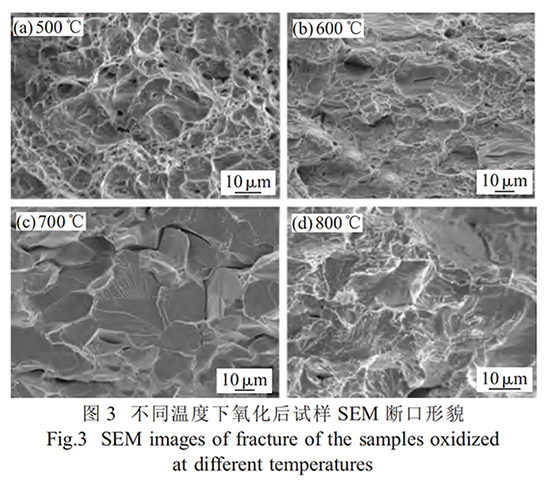
3 Conclusion
(1) 500 ℃ oxidation, the diffusion of O elements on the mechanical properties of niobium-tungsten alloy has little effect.
(2) When oxidized at 600~800℃, the oxides generated are mainly NbO2 and Nb4O5.
(3) When oxidized at 700℃, with the increase of Nb4O5, non-protective oxide film is formed, and the diffusion of oxygen leads to brittle fracture of the alloy, and the alloy cannot be used for a long time at this temperature.
(4) 800 ℃ oxidation, the generation of the oxide is mainly NbO2, with a certain degree of protection, the alloy has a certain toughness.
About Stardust Technology
Stardust Technology (Guangdong) Co., Ltd. is a national high-tech enterprise specializing in the research, development, production and sales of high-end spherical powder materials for 3D printing, powder metallurgy, surface engineering and other fields. The company adheres to the radio frequency plasma spheroidization powder making technology as the core, providing international advanced powder products and application solutions.
The company's main products include tungsten, molybdenum, tantalum, niobium, vanadium, rhenium, chromium and other high-end rare and refractory metals and their alloys, compounds spherical powder, while providing RF plasma spheronization, plasma rotating electrode atomization, 3D printing, hot isostatic pressing, injection molding, powder metallurgy and other technical services.
The spherical Nb521 refractory alloy powder produced by Stardust Technology is made by RF plasma spheronization atomization method, which is characterized by high purity oxygen deficiency, high sphericity, smooth surface, no satellite, uniform particle size distribution, excellent flow properties, high bulk density and vibration density.
Niobium-tungsten alloy Nb521 is widely used in the manufacture of aerospace engines, weapon propellers, liquid two-component engines for rockets and missiles, nuclear reactors, submersibles, gas turbines, automobile engines, diesel engines, high-temperature furnace heating tapes, high-temperature molds, high-temperature fixtures, and high-temperature crucibles.
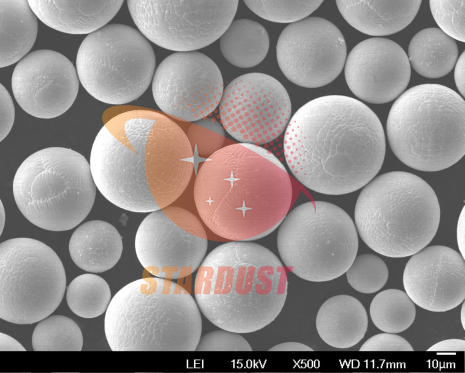
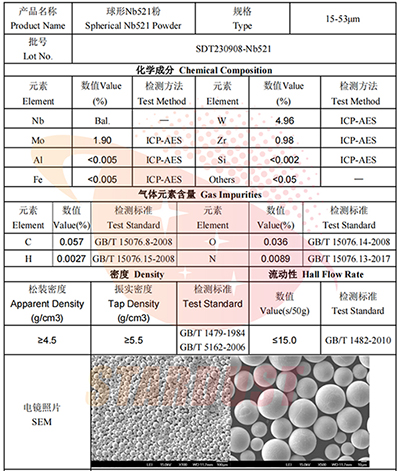
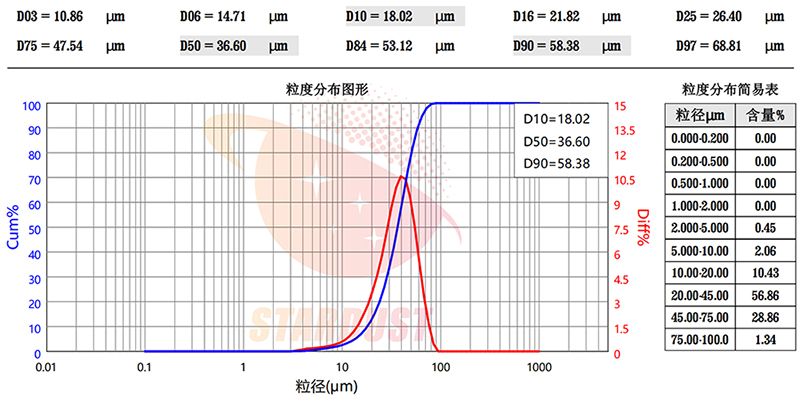
For more information, please feel free to contact us

Paper Citation Information:
Hot Working Technology 2021, Vol. 50, No. 24
DOI: 10.14158/j. cnki. 1001-3814. 20212705
Chinese Figure Classification:TG151.1 Literature Identification Code:A Article Number:1001-3814(2021)24-0036-03